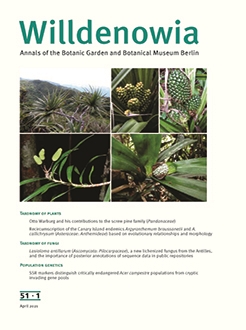Van de Vijver B., Tudesque L. & Ector L. (ed.), Diatom taxonomy and ecology. From France to the sub-Antarctic islands. Celebrating the work and life of Prof. Dr. René Le Cohu on the occasion of his 80th birthday. – Nova Hedwigia Beiheft 146. – Stuttgart: J. Cramer in Borntraeger Science Publishers, 2017. – ISBN 978-3-443-51068-8. – 17 × 24 cm, 780 g, 325 pp., 1210 figures, 24 tables, softback. – Price: EUR 139.00. – Available at https://www.schweizerbart.de/papers/nova_suppl/list/146#issue
Citation: Mora D. 2021: Book review: Van de Vijver B., Tudesque L. & Ector L. (ed.), Diatom taxonomy and ecology. From France to the sub-Antarctic islands. Celebrating the work and life of Prof. Dr. René Le Cohu on the occasion of his 80th birthday. – Willdenowia 51: 33–34.
Version of record first published online on 15 February 2021 ahead of inclusion in April 2021 issue.
This supplement (Beiheft 146) of Nova Hedwigia is dedicated to Prof. Dr. René Le Cohu on the occasion of his 80th birthday, as a recognition of his illustrious career in both basic and applied phycology, particularly for his extensive contributions to diatom research.
The book starts with a tribute to the life and research of Prof. Le Cohu, entitled “Tribute to Prof. Dr. René Le Cohu: from Brittany to the Pyrenees passing by the Kerguelen Islands” from Luc Ector and Bart Van de Vijver. The book continues with 20 original contributions covering a broad spectrum of diatomology, ranging from taxonomy and ecology to molecular phylogenetics and DNA barcoding. These 20 studies analyse diatom material coming from a variety of regions including Asia, Europe, North and South America and some sub-Antarctic Islands. The studied materials primarily come from recent diatoms, mostly epilithic and epiphytic, although there are also planktic and epizoic (turtle shells) samples, as well as surface and quaternary sediments. These studies were prepared by more than 40 authors, mostly well-recognized and long-established diatom researchers. But a few studies were led by young scientists, e.g. Foets & al. (2017), García & al. (2017) and Glushchenko & al. (2017), important in fields like diatom taxonomy, which is seeing a decrease in recruitment over time.
Taxonomy makes up the bulk of this book, with 17 articles devoted to this field. One order, one family, three genera, 22 species and one variety are described as new. The newly described infrageneric taxa belong to the following genera: Arcanodiscus Maidana & E. Morales (1 infrageneric taxon), Cocconeis Ehrenb. (1), Crati-cula Grunow (1), Cyclostephanos Round (1), Cyclotella (Kütz.) Bréb. (1), Diploneis (Ehrenb.) Cleve (2) Labellicula Van de Vijver & Lange-Bert. (1), Luticola D. G. Mann (11), Michelcostea Van de Vijver & al. (1), Na-vicula Bory (1), Placoneis Mereschk. (1) and Staurosira Ehrenb. (1). Four of these studies include analyses of type material. Eight of the 14 studies describing new taxa include comparative tables, which might be very helpful for the reader, because they condense the information compared to written differential diagnoses. These tables also make it easier to find and compare the differentiating characters of the newly described taxon to their closely related ones. It is worth mentioning that most of the studies describing new taxa include some ecological data of the new species, which can be of help to ecologists, hydrobiologists, and all researchers dealing with the distribution and ecology of the newly described taxa.
The remaining three articles deal with (1) the enigmatic genus Envekadea Van de Vijver & al., which is shown to belong within the family Pinnulariaceae in a molecular phylogeny; (2) the performance of morphological and molecular methods (DNA barcoding) in the identification of freshwater diatoms; and (3) the palaeolimnological reconstruction of changes in the water quality of a pond to determine if its restoration to a less eutrophic state is possible.
The last part of this book presents the bibliographic and diatom taxonomic data related to the career of Prof. Dr. Le Cohu. First, a list of 43 diatom taxa described or recombined by René Le Cohu is given, giving proof of his prolific taxonomic legacy. This is followed by a list of 17 taxa dedicated to him, six of which are described in this book. Finally, a list of the publications of Prof. Le Cohu is provided, spanning an impressive timespan of 52 years (1965–2017), but this period continues to grow because he is as active now in diatom research as he has been before.
No major flaws are to be mentioned for this book made of a collection of articles. However, it is quite puzzling to read in Majewska & al. (2017) that it is not completely clear whether the newly described Labellicula lecohuiana Majewska & Van de Vijver belongs to Labellicula or to Olifantiella Riaux-Gob. & Compère, this because of the close relationship of the two genera. The authors mention that an integrative taxonomic study including molecular data might help in solving this puzzle.
Nowadays, it can be baffling for diatom taxonomists to see articles describing new species without providing scanning electron microscopy (SEM) pictures, as is the case for the contribution by Lange-Bertalot & Fuhrmann (2017) presenting two new Diploneis species. The authors of this study argue that the diagnostic characteristics of the new species are clear enough to be seen in light microscopy (LM) but then mention this might not be the case when more material is analysed, particularly for the rare D. fereparma Lange-Bert. & Fuhrmann. Recently, the diagnoses of both taxa were amended and more LM pictures provided, yet there are no SEM pictures of these two species (Lange-Bertalot & al. 2020).
Overall, the contributions included in this book are well written and the taxa are effectively illustrated in LM and SEM. This book is a must-have for any institution dedicated to the taxonomy of diatoms. Additionally, it can be a very useful tool for other researchers, such as ecologists and palaeolimnologists.





